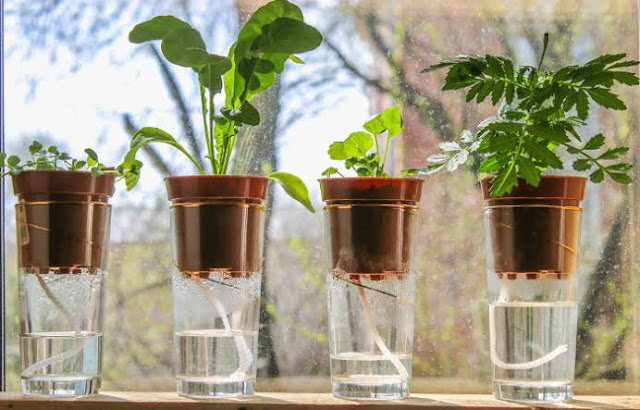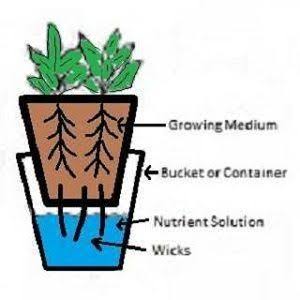 |
| @mollygreen.com |
One of the hydroponic planting systems chosen by beginners who are still learning and are just starting out in the hydroponic planting world is the wick system.
The wick system, also known as the wick system, is a hydrophonic planting system that uses stagnant water in a container where each planting pot uses a flannel or other cloth that easily absorbs water, the function of this axis to deliver nutrient water to the plant roots.
The wick system is the cheapest and easiest system to implement, because this system can use used equipment that is widely available at home such as used plastic bottles for mineral water, used conductors, leftover vpc pipes that are not used, and so on, the important thing is that the container is able to accommodate water and preferably not made of metal.
The hydroponics system of the wick is indeed very suitable for beginners who are just starting out wanting to plant hydroponics, with a fairly cheap capital from this system beginners will learn a lot about how to care for hydroponic plants so that over time they will be able to recognize any problems with hydroponic plants, especially the wick system.
Regarding the wick system in this article, I will try to describe the advantages and disadvantages of the wick system that you should know, so that by recognizing the advantages and disadvantages you can at least consider choosing this wick system and can anticipate any problems with this wick system.
 |
Pros and Cons of the wick system.
The wick system is indeed very simple and very cheap, when compared to other systems such as the DFT system, NFT, floating raft systems, this wick system is considered the cheapest hydrponic system, but this wick system is quite difficult in practice.
1. The advantages of the Wick system
For beginners, you can start to try hydronomic cultivation with the wick system, the advantages of the wick system are as follows:
a. Low cost
The wick system can use used items that are widely available at home, such as plastic containers, used mineral water bottles, styrofoam food boxes, fruit styrofoam boxes and so on, by using planting media that are widely available at home, it will save costs.
b. The wick system does not need to use a Pump
In the wick system, there is actually no need to use a pump, either an aerator pump, but a water pump, however, if you have more capital, you can use an air pump or aerator pump to supply oxygen to the wick system water which is generally stagnant, aka not flowing.
With the addition of an erator pump, at least you don't have to bother messing around with nutrient water manually.
2. Disadvantages of the Wick system
Besides having the advantages of the hydroponic wick system it also has several weaknesses that you should be aware of, the disadvantages of the wick system are as follows:
a. Fairly difficult maintenance.
In my opinion, the wick system is one of the hydrponic systems that is less practical, we will be quite bothered when maintaining, especially when the number of plants and planting media is large, such as when replacing nutrient water when the nutrient water in the wick system container runs out, or when you want to increase the PPM value of water. nutrition.
If there is more than one container, we will be quite bothered when giving nutritional water, either when using nutrient water for oxygen, want to increase the PPM of nutrient water or when you want to add nutrient water because it runs out, especially just before harvest the water will be fast. run out and we have to frequently check and add nutrient water when the water is absorbed by the plants at low tide.
b. Less optimal plant growth
Hydroponic plants are very much determined by the oxygen content in nutrient water, the PPM value of nutrient water and nutrient water temperature, if one of them is less then the growth of hydroponic plants can be guaranteed to be disrupted and less than optimal, and even could die
In a wick system with stagnant water without an aerator, if we are less painstaking in maintenance, it could be that the nutrient water will lack oxygen, or the water temperature rises which results in slower plant growth.
c. Easily exposed to root rot
Because it uses stagnant water, if the temperature rises and the water is deprived of oxygen, then if it is allowed to continue, it will affect the pH of the nutrient water which increases and if it is allowed to continue, it can cause root rot due to fungal growth in the plant roots, so that the plant can wither and die.
SOLUTION
The shortcomings above can actually be avoided if we painstakingly maintain our hydrophonic plants that use the wick system. as follows:
- Keeping the water supplied with oxygen can be done manually by pulverizing the water every day at least once, or adding an aerator pump.
- Avoid overheating the water and air around the planting media container, we can dry it under UV plastic (Grand house), or give a light color to the lid or container of the planting media used.
- Ensuring that plants get the right PPM value, so that it is easier for us to use a TDS Meter.
- More painstaking maintenance
With the above efforts, it is likely that our hydronomic plants that use the wick system, whether from used bottles, styrofoam rice boxes, or used styrofoam boxes of fruit and other media can grow well and can harvest optimally.
http://strukturkode.blogspot.com/2020/08/kelebihan-dan-kekurangan-hidrponik-sistem-wick.html